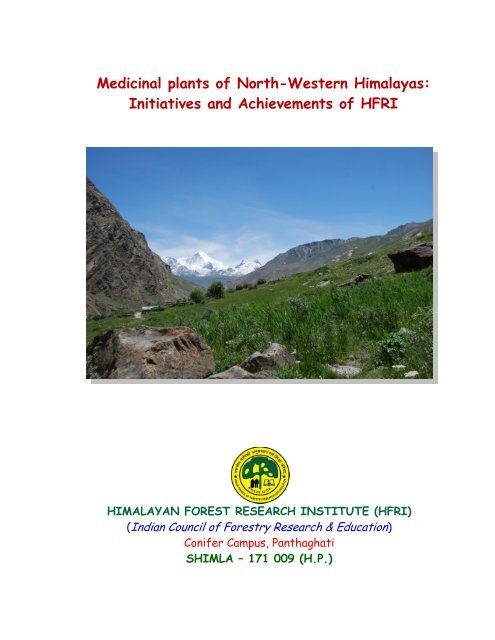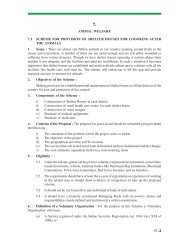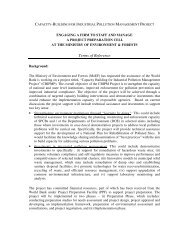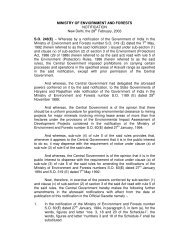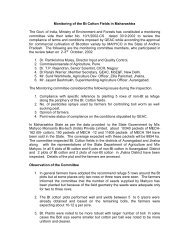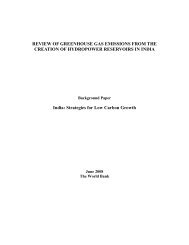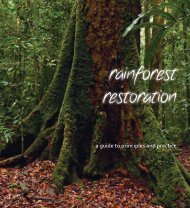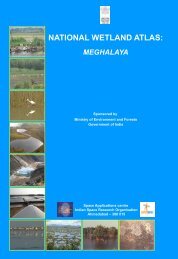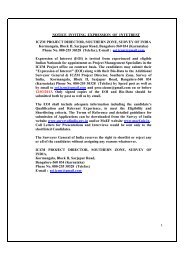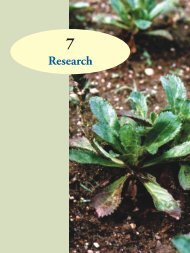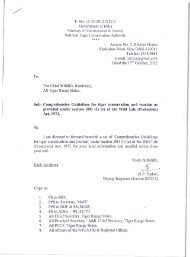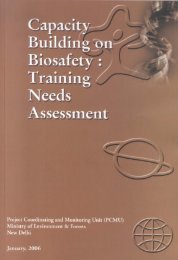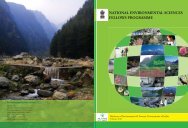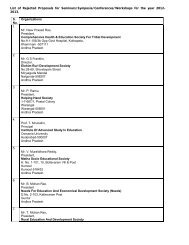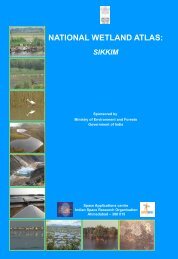Medicinal plants of North-Western Himalayas - Ministry of ...
Medicinal plants of North-Western Himalayas - Ministry of ...
Medicinal plants of North-Western Himalayas - Ministry of ...
You also want an ePaper? Increase the reach of your titles
YUMPU automatically turns print PDFs into web optimized ePapers that Google loves.
<strong>Medicinal</strong> <strong>plants</strong> <strong>of</strong> <strong>North</strong>-<strong>Western</strong> <strong>Himalayas</strong>:<br />
Initiatives and Achievements <strong>of</strong> HFRI<br />
HIMALAYAN FOREST RESEARCH INSTITUTE (HFRI)<br />
(Indian Council <strong>of</strong> Forestry Research & Education)<br />
Conifer Campus, Panthaghati<br />
SHIMLA – 171 009 (H.P.)
<strong>Medicinal</strong> <strong>plants</strong> <strong>of</strong> <strong>North</strong>-<strong>Western</strong> <strong>Himalayas</strong>:<br />
Initiatives and Achievements <strong>of</strong> HFRI<br />
<strong>North</strong>-western Himalayan region with its wide range <strong>of</strong> altitudes, topography and climatic<br />
conditions, is a rich repository <strong>of</strong> medicinal wealth, which occupies an important place in Vedic<br />
treatise. More than 800 no. valuable medicinal species found in this part <strong>of</strong> India is extensively<br />
used by the locals since time immemorial for curing various diseases <strong>of</strong> humankind. It is now a<br />
well known fact that medicinal <strong>plants</strong> sector possesses great potential to uplift the economy <strong>of</strong> this<br />
part <strong>of</strong> India. However, various developmental and anthropogenic pressures on the forests,<br />
unscrupulous/unscientific exploitation <strong>of</strong> medicinal <strong>plants</strong> in the wake <strong>of</strong> their increasing national<br />
and a global trade, inadequacy <strong>of</strong> management inputs and lack <strong>of</strong> enabling legislation have caused<br />
severe depletion <strong>of</strong> the medicinal <strong>plants</strong> resource base thereby affecting the health and livelihood<br />
options <strong>of</strong> the people. The situation may further aggravate if some corrective measures are not put<br />
in place. Moreover, the trade in medicinal <strong>plants</strong> in the region is largely un-regulated, secretive<br />
and exploitative and takes place in the form <strong>of</strong> raw material. Even the post harvest handling <strong>of</strong> the<br />
raw material does not generally conform to the well laid down norms resulting in low<br />
remuneration to the poor rural people for their efforts to collect/cultivate medicinal <strong>plants</strong>, who<br />
have very small land holding and dependant on such activities for additional income.<br />
Encouraging commercial cultivation is vital for the success <strong>of</strong> medicinal <strong>plants</strong> sector to meet out<br />
the ever growing demand for temperate medicinal <strong>plants</strong> as this wealth has been depleting<br />
continuously since last two decades in their natural habitat. Biodiversity Conservation and<br />
Sustainable development <strong>of</strong> medicinal <strong>plants</strong> sector require active participation <strong>of</strong> local<br />
communities and people friendly policies. For obtaining common man’s support in medicinal<br />
<strong>plants</strong> sector, it must be linked with economic viability.<br />
Himalayan Forest Research Institute (HFRI), Shimla being one <strong>of</strong> the regional institute <strong>of</strong> Indian<br />
Council <strong>of</strong> Forestry Research and Education (ICFRE), Dehradun also started its focussed attention<br />
towards research and developmental activities in the <strong>Medicinal</strong> Plants Sector in <strong>North</strong>-<strong>Western</strong><br />
<strong>Himalayas</strong> since last decade. Accordingly, in its concerted efforts the institute was able to generate<br />
following knowledge in this direction:<br />
1. Survey in Some Important and Fragile Eco-Systems:<br />
With an intention to augment the earlier literature, the institute undertook survey in different<br />
ecologically sensitive and fragile zones in the state <strong>of</strong> Himachal<br />
Pradesh. Accordingly, a zist <strong>of</strong> information on the medicinal <strong>plants</strong><br />
as per their status has been prepared which is as below;<br />
1.1. Cold Deserts- The Ecologically Fragile Areas:<br />
The institute conducted survey in different areas <strong>of</strong> cold deserts in<br />
Pooh sub division <strong>of</strong> district Kinnaur, Himachal Pradesh revealed<br />
the presence <strong>of</strong> 114 medicinal plant species from the area. Out <strong>of</strong><br />
Saussurea gossypiphora<br />
1
these medicinal <strong>plants</strong>, 24 species i.e. Aconitum heterophyllum,<br />
Aconitum violaceum, Arnebia euchroma, Bergenia stracheyi, Betula<br />
utilis, Dactylorhiza hatagirea, Datisca cannabina, Ephedra<br />
gerardiana, Ferula jaeskeana, Hippophae rhamnoides, Hyssopus<br />
<strong>of</strong>ficinalis, Hyoscyamus niger, Juniperus polycarpos, Jurinea<br />
dolomiaea, Meconopsis aculeata, Picrorhiza kurrooa, Polygonatum<br />
verticillatum, Rheum webbianum, Rheum moorcr<strong>of</strong>tianum, Rhodiola<br />
heterodonta, Rhododendron anthopogon, Rhododendron<br />
campanulatum, Saussurea gossypiphora, Saussurea obvallata fall in<br />
different categories <strong>of</strong> threatened <strong>plants</strong>.<br />
The similar exercise for documentation <strong>of</strong> <strong>Medicinal</strong> <strong>plants</strong> in Miyar Valley <strong>of</strong> the district Lahaul<br />
& Spiti <strong>of</strong> the state showed the presence <strong>of</strong> 50 most promising medicinal <strong>plants</strong> and some <strong>of</strong> them<br />
are; Podophyllum hexandrum, Meconopsis aculeata, Viola biflora, Geranium wallichianum, Rosa<br />
webbiana, Bergenia stracheyi, Potentilla atrisanguinea, Angelica glauca, Bunium persicum,<br />
Ferula jaeskeana, Pleurospermum brunonis, Inula racemosa, Arnebia euchroma, Picrorhiza<br />
kurrooa, Rheum australe, Polygonatum verticillatum, Trillium govanianum etc.<br />
1.2. Wild-life Sanctuaries: The Area <strong>of</strong> Interest<br />
Ferula jaeschkeana<br />
These Protected Areas are another important area <strong>of</strong> interest and provides uniqueness to the<br />
thought process <strong>of</strong> the stakeholders in general and the specialist in particular. Findings <strong>of</strong> some <strong>of</strong><br />
the prioritized sanctuaries revealed as below;<br />
The survey in Rakchham-Chitkul Wildlife Sanctuary, district<br />
Kinnaur (Himachal Pradesh) included the presence <strong>of</strong> 98 plant<br />
species <strong>of</strong> medicinal importance. Twenty two plant species <strong>of</strong><br />
threatened categories were recorded from the sanctuary, out <strong>of</strong><br />
which 3 were critically endangered, 11 endangered and 13<br />
vulnerable. Critically Endangered species include Aconitum<br />
heterophyllum, Dactylorhiza hatagirea and Saussurea obvallata<br />
where as Acer caesium, Angelica glauca, Betula utilis, Dioscorea<br />
deltoidea, Jurinea dolomiaea, Meconopsis aculeata, Picrorhiza Saussurea obvallata<br />
kurrooa, Podohyllum hexandrum, Polygonatum cirrihifolium,<br />
Rheum australe and Taxus wallichiana fall in Endangered category and Vulnerable species<br />
include Aconitum violaceum, Bergenia stracheyi, Heracleum lanatum, Hippophae rhamnoides,<br />
Ferula jaeschkeana, Polygonatum verticillatum, Polygonatum multiflorum, Rheum webbianum,<br />
Rhodiola heterodonata, Rhododendron anthopogon, R.campanulatum and R. lepidotum.<br />
Renuka and Simbalwara Wildlife Sanctuaries have the presence <strong>of</strong> 95 <strong>plants</strong> <strong>of</strong> medicinal value.<br />
Some <strong>of</strong> the medicinal <strong>plants</strong> recorded are; Acorus calamus, Aegle marmelos, Asparagus<br />
racemosus, Celastrus paniculata, Chonemorpha fragrans, Gloriosa superba, Hedychium<br />
spicatum, Nelumbo nucifera, Nervilia prainiana, Oroxylum indicum, Pistacia chinensis, Smilax<br />
aspera, Zanthoxylum armatum etc.<br />
2
Out <strong>of</strong> 100 medicinal plant species recorded in Kalatop- Khajjiar Wildlife Sanctuary, 7 species<br />
viz; Cinnamonum tamala, Dioscorea deltoidea, Paris polyphylla, Podophyllum hexandrum,<br />
Polygonatum verticillatum, Taxus wallichiana, Zanthoxylum armatum fall in the category <strong>of</strong><br />
threatened <strong>plants</strong>. Recording <strong>of</strong> new floral elements including those <strong>of</strong> medicinal <strong>plants</strong> in<br />
Churdhar Wildlife Sanctuary had also paved the way for additional thrust on such areas <strong>of</strong> interest.<br />
2. Establishment <strong>of</strong> Germplasm bank and Propagation Techniques:<br />
The Institute has established the Germplasm bank <strong>of</strong> 30 species <strong>of</strong> medicinal <strong>plants</strong> <strong>of</strong> temperate<br />
<strong>Himalayas</strong> in Brundhar nursery (Manali); 20 species at Shilly nursery, Solan and 10 species each<br />
at Shillaru Nursery (Shimla) and Model Nursery (Shimla) for demonstration purpose to different<br />
stakeholders. Studies were conducted for improvement in the nursery techniques <strong>of</strong> economically<br />
important medicinal plant species e.g. Picrorhiza kurrooa (Kutki), Aconitum heterophyllum<br />
(Patish), Valeriana jatamansi (Mushkbala), Angelica glauca (Chora) etc. Developed marcoproliferation<br />
technique for mass multiplication <strong>of</strong> Kutki and Mushakbala as explained below:<br />
2.1. Macro-proliferation technique for Kutki multiplication<br />
Picrorhiza kurrooa, Royle ex Benth. commonly known as Kutki is an important temperate<br />
medicinal plant species found in western <strong>Himalayas</strong>. It possesses great potential for commercial<br />
cultivation in higher temperate regions. It possesses inherent proliferation capacity and <strong>of</strong>fset<br />
planting capabilities to reproduce it. The well grown mature plant <strong>of</strong> Kutki can be utilized for<br />
vegetative multiplication by exploiting such characters <strong>of</strong> the species. Keeping this clue in mind,<br />
macro-proliferation technique was developed for vegetative multiplication <strong>of</strong> this important<br />
medicinal plant species. The technique ensures that each propagules possesses some parts <strong>of</strong> shoot<br />
along with rhizome parts and few roots at the time <strong>of</strong> separation from mature healthy plant. By the<br />
application <strong>of</strong> this technique a healthy mature plant <strong>of</strong> Kutki can be multiplied 6 to 10 times<br />
successfully. In addition to multiplication >50% yield <strong>of</strong> rhizomes and roots can be recovered for<br />
marketing or various other uses. Time <strong>of</strong> separation, portion <strong>of</strong> shoot/root/rhizome to be retained<br />
in each propagule and providing appropriate growing conditions for plantation <strong>of</strong> separated<br />
propagules are found to be critical factors for achieving success through this technique. In general<br />
it is always better to go for this technique during rainy season and plantation <strong>of</strong> propagules in<br />
poly-house or sand trays.<br />
Mature plant <strong>of</strong> Kutki Macro-proliferated propagules<br />
3
2.2. Macro-proliferation technique for Mushakbala multiplication<br />
Valeriana jatamansi, Jones commonly known as Mushakbala is an important temperate medicinal<br />
plant species found in western <strong>Himalayas</strong> and possesses great potential for commercial cultivation.<br />
The species can be easily grown through seeds but the vegetative propagation has scientific<br />
advantage over sexual propagation. The well grown mature plant <strong>of</strong> Mushakbala can be utilized<br />
for vegetative multiplication by exploiting such characters <strong>of</strong> the species. Keeping this the above<br />
in mind, macro-proliferation technique has been developed for vegetative multiplication <strong>of</strong> this<br />
important medicinal plant species. This technique ensures that each propagule possesses some<br />
parts <strong>of</strong> shoot along with rhizome parts and roots at the time <strong>of</strong> separation from mature healthy<br />
<strong>plants</strong>. By the application <strong>of</strong> this technique a healthy mature plant <strong>of</strong> Mushakbala can be<br />
multiplied 10 to 12 times successfully. In addition to multiplication >50% yield <strong>of</strong> rhizomes and<br />
roots can be recovered for marketing or various other uses. Time <strong>of</strong> separation, portion <strong>of</strong><br />
shoot/root/rhizome to be retained in each propagule and providing appropriate growing conditions<br />
for plantation <strong>of</strong> separated propagules are found critical factors for achieving success through this<br />
technique. In general it is always better to go for this technique during rainy season.<br />
Mature Plant <strong>of</strong> Mushakbala Macro-proliferated propagule<br />
2.3. Fabrication <strong>of</strong> Equipments:<br />
A „Multiple Nursery Planting Bar‟ has been designed and developed for maintaining desired<br />
spacing at field or commercial level. The equipment not only marks the surface <strong>of</strong> nursery<br />
bed/field for precision planting but also creating cavities or planting holes for inserting propagules<br />
<strong>of</strong> <strong>Medicinal</strong> <strong>plants</strong>. It is dual purpose equipment as it maintains desired spacing as well as creates<br />
cavities for inserting propagules. Its operation results into 9 no. bed marks at 30cm x 30cm spacing<br />
with around 10cm deep cavity/planting hole at each mark.<br />
3. Production <strong>of</strong> quality planting material <strong>of</strong> selected medicinal plant species:<br />
Around 8.0 lacs quality planting material <strong>of</strong> Picrorhiza kurrooa Royle Ex. Benth, Valeriana<br />
jatamansi Jones, Aconitum heterophyllum Wall. ex Royle & Angelica glauca Edgew were<br />
produced under NMPB sponsored projects during last five years, <strong>of</strong> which around 7.0 lakhs<br />
planting stocks were distributed to various end users for cultivation and further multiplication.<br />
4
Various extension activities were also carried out by organising training and demonstration<br />
programmes, village open meetings and publication <strong>of</strong> extension materials in simple vernacular<br />
language for the benefit <strong>of</strong> various end users.<br />
Raising <strong>of</strong> QPM <strong>of</strong> V.jatamansi<br />
4. Development <strong>of</strong> suitable model for intercropping for commercially important<br />
medicinal <strong>plants</strong> with horticultural plantations in temperate regions <strong>of</strong> Himachal<br />
Pradesh<br />
Himachal Pradesh basically a horticultural state<br />
accordingly temperate fruit growing is the main activity<br />
<strong>of</strong> mid and higher hill farmers. Till recently growing <strong>of</strong><br />
temperate fruits was lucrative business but continuous<br />
failure <strong>of</strong> these fruit crops due to erratic rainfall<br />
accompanied with very less snow fall, increased<br />
incidence <strong>of</strong> various insect pest and diseases attacks,<br />
overall rising temperature and decreasing forest areas <strong>of</strong><br />
the region, shortened chilling hours required by the apple<br />
trees during winter for optimum flowering and fruit<br />
Raising <strong>of</strong> QPM <strong>of</strong> P. kurrooa<br />
Raising <strong>of</strong> QPM <strong>of</strong> Aconitum heterophyllum Raising <strong>of</strong> QPM <strong>of</strong> Angelica glauca<br />
Preparation <strong>of</strong> field beds in the<br />
interspaces <strong>of</strong> horticultural plantation<br />
setting thereby resulting in low yields and lower qualities have forced the farmers/ horticulturist to<br />
look for some other alternatives to supplement their income through diversification. The Institute<br />
worked on these lines and through scientific inputs was able to develop the model <strong>of</strong> intercropping<br />
5
that could be viable and will help farmers to augment their income besides helping in productivity<br />
enhancement per unit area <strong>of</strong> land and in mitigating the poverty in rural areas.<br />
4.1. Intercropping model <strong>of</strong> Aconitum heterophyllum (Patish):<br />
The species is suitable for intercropping with horticultural<br />
plantations <strong>of</strong> Apple (Malus domestica Borkh.) and<br />
Cherry (Prunus avium Linn.) in high hill temperate zone.<br />
Seedlings should be planted in the spacing <strong>of</strong> 30x20 cm 2<br />
in the field beds. Irrigation after weekly interval is<br />
recommended during hot summer season for optimum<br />
growth and yield. Apple orchard <strong>of</strong> age between 16 to 20<br />
years have been found to be best for optimum yield <strong>of</strong> the<br />
Aconitum heterophyllum. After harvesting roots have to<br />
Aconitum heterophyllum with Apple<br />
be thoroughly washed with clean water and dried under<br />
shade and packed. Root parts contain active ingredient called Atisine (0.4%), which is <strong>of</strong><br />
commercial importance. After two and half years the average yield was found to be 202 Kg/ ha.<br />
The market rate may vary from `1300 to `2200/- per Kg. Aconitum heterophyllum (Patish) may<br />
fetch a net return <strong>of</strong> `1,52,000/- to `3,30,000/- per ha.<br />
4.2. Intercropping <strong>of</strong> Valeriana jatamansi (Muskbala)<br />
Seedlings should be planted in the spacing <strong>of</strong> 30x40 cm 2 in the<br />
field beds. Irrigation after day's interval is recommended during<br />
hot summer season for optimum growth and yield. Apple orchard<br />
<strong>of</strong> age 30 years has been found to be best for optimum yield.<br />
After harvesting roots have to be thoroughly washed with clean<br />
water and dried under shade and packed. Root parts contain<br />
active ingredient called Valepotriate and Volatile essential oil<br />
(0.5%) which is <strong>of</strong> commercial importance. After two and half<br />
years the average yield was 12 quintal/ ha. The market rate may Valeriana jatamansi with Apple<br />
vary from `120 to `150/- per Kg. Valeriana jatamansi (Muskbala) may fetch a net return <strong>of</strong><br />
`40,000/- to `80,000/- per ha.<br />
4.3. Intercropping <strong>of</strong> Picrorhiza kurrooa (Kutki):<br />
In the interspaces <strong>of</strong> horticultural plantations field beds should be<br />
prepared during the month <strong>of</strong> February-March. Seedlings should<br />
be planted in the spacing <strong>of</strong> 30x40 cm 2 in the field beds.<br />
Irrigation after weekly interval is recommended during hot<br />
summer season for optimum growth and yield. Apple orchard <strong>of</strong><br />
age between 26 to 36 years has been found to be best for<br />
optimum yield. After harvesting roots have to be thoroughly<br />
P. kurrooa with Apple<br />
washed with clean water and dried under shade and packed. Root<br />
parts contain active ingredient called Picroside-1 and Picroside-II which is <strong>of</strong> commercial<br />
6
importance. After two and half years the average yield was 07 quintal/ ha. The market rate may<br />
vary from `200/-to `225/- per Kg. Picrorhiza Kurooa (Kutki) may fetch a net return <strong>of</strong> `40,000/-<br />
to `57,000/- per ha.<br />
4.4 Intercropping Angelica glauca (Chora) with horticultural plantations:<br />
The species is suitable for intercropping with horticultural plantations <strong>of</strong> Apple (Malus domestica<br />
Borkh.) and Cherry (Prunus avium Linn.) in high<br />
temperate zone. Seedlings should be planted in the<br />
spacing <strong>of</strong> 45x75 cm 2 in the field beds. Irrigation after<br />
weekly interval is recommended during hot summer<br />
season for optimum growth and yield. Apple orchard<br />
<strong>of</strong> age between 26 to 30 years has been found to be<br />
best for optimum yield. After harvesting roots have to<br />
be thoroughly washed with clean water and dried<br />
under shade and packed. Root parts contain Glycosides<br />
Angelica glauca with Apple<br />
which is <strong>of</strong> commercial importance. After two and half<br />
Angelica glauca with Apple<br />
years the average yield was 23 quintal/ ha. The market rate may vary from `60/-to `100/- per Kg.<br />
Angelica glauca (Chora) may fetch a net return <strong>of</strong> `38,000/- to `1,30,000/- per ha*.<br />
* The market rate for medicinal and aromatic <strong>plants</strong> is fluctuating, hence the economics may vary.<br />
5. Under the project "Promotion <strong>of</strong> <strong>Medicinal</strong> Plants Cultivation among Rural<br />
Communities for Sustainable Income Generation” funded by Himachal Pradesh Forestry<br />
Sector Reform Project (HPSFRP) <strong>of</strong> Himachal Pradesh Forest Department under Big Good Idea<br />
Fund (GIF) in theme: Mountain Based Farming System; the Institute had established<br />
demonstration plots (3 no’s) <strong>of</strong> important medicinal <strong>plants</strong> in different altitudinal zones (Lower,<br />
Mid and High zones) <strong>of</strong> Sirmour district, Himachal Pradesh. Besides, organized training and<br />
demonstration programmes (8 nos.) to different target groups on medicinal <strong>plants</strong> cultivation and<br />
also developed user friendly extension materials.<br />
6. Berberis aristata (Daruhaldi)<br />
The Institute in collaboration with Forest Research Institute, Dehradun has identified seven<br />
A view <strong>of</strong> Berberis aristata plant Roots <strong>of</strong> Berberis aristata<br />
7
provenances <strong>of</strong> Berberis aristata in Himachal Pradesh and identified high berberine (2.81%)<br />
yielding plant populations under the project titled "Studies on population status and berberine<br />
content in different provenances <strong>of</strong> Berberis aristata DC. in Himachal Pradesh and<br />
standardization <strong>of</strong> its propagation techniques" sponsored by Department <strong>of</strong> Biotechnology,<br />
Government <strong>of</strong> India. Propagation techniques were also standardized for the species.<br />
7. <strong>Medicinal</strong> <strong>plants</strong> in Sacred Groves <strong>of</strong> Kullu Valley<br />
<strong>Medicinal</strong> <strong>plants</strong> in Sacred groves <strong>of</strong> Kullu Valley, Himachal Pradesh was documented under the<br />
project on “Inventorization, documentation <strong>of</strong> plant diversity and to evolve site-specific<br />
management strategies for conservation <strong>of</strong> various sacred groves in Kullu Valley <strong>of</strong><br />
Himachal Pradesh” sponsored by the GB Pant Institute <strong>of</strong> Himalayan Environment &<br />
Development, Almora under Integrated Eco-development Research Programme.<br />
A sacred grove in Nashala village, Kullu Valley, Himachal Pradesh<br />
8. Standardized the methodologies for Seed Collection, Seed Handling, Storage and<br />
Breaking Seed Dormancy in Juniperus polycarpos C.Koch and Fraxinus<br />
xanthoxyloides (Wall. ex G. Don) DC” the Institute has successfully conducted trials on<br />
seed collection, processing, storage and pre-sowing treatments in Juniperus polycarpos and<br />
Fraxinus xanthoxyloides. The extension material for the benefit <strong>of</strong> various end users is being<br />
developed and mass production <strong>of</strong> nursery stock <strong>of</strong> these species is under process.<br />
Juniperus polycarpos seedlings raised at Model Nursery, Shimla<br />
8
9. Survey, Biology and Control <strong>of</strong> Insect-Pests <strong>of</strong> Important <strong>Medicinal</strong> Plants in<br />
Himachal Pradesh”<br />
During the survey 37 insect species belonging to 5 insect orders viz. Lepidoptera, Coleoptera,<br />
Hemiptera, Orthoptera, Hymenoptera and 24 families, Class Arachnida, were found to be<br />
associated with medicinal <strong>plants</strong> in the nurseries. Plusia orichalcea is one <strong>of</strong> the important insectpests<br />
associated with medicinal <strong>plants</strong>. Biopesticides viz. Neem cake @ 500 gm / m 2 , Grownim @<br />
5.0 % and summer oil @ 5.0 % is proved to be effective to keep the population <strong>of</strong> Plusia<br />
orichalcea Fabr. (Lepidoptera ; Noctuidae) below Economic Threshold Level in medicinal crop<br />
like Saussurea costus, Acronitum heterophyllum, Picrorhiza kurrooa, Heraclium candicans,<br />
Angelica glauca and Valeriana jatamansi.<br />
Apple Mite infested <strong>plants</strong> <strong>of</strong> Valeriana jatamansi Moth <strong>of</strong> Cabbage semilooper in Kuth<br />
10. Identification <strong>of</strong> Superior Genetic Stock <strong>of</strong> Podophyllum hexandrum (Bankakdi)<br />
from from H.P. and J & K: & K:<br />
The Institute has carried out extensive surveys to identify<br />
the superior genetic stock <strong>of</strong> Podophyllum hexandrum in<br />
different geographical locations (25 No.) <strong>of</strong> Himachal<br />
Pradesh and Ladakh (J & K) and collected genetic<br />
material from the same. Trials are being conducted to<br />
develop user friendly propagation methods <strong>of</strong> the species.<br />
On the basis <strong>of</strong> high active ingredient content identified<br />
the superior chemo-types and has established the Field<br />
Gene Bank (FGB) <strong>of</strong> the same.<br />
P. hexandrum in natural<br />
habitat<br />
11. Network project on Population assessment and identification <strong>of</strong> superior genetic<br />
stock <strong>of</strong> Picrorhiza kurrooa Royle ex Benth and Valeriana jatamansi Jones by<br />
screening different populations from <strong>North</strong>-<strong>Western</strong> <strong>Himalayas</strong> (H.P. and<br />
Uttarakhand)<br />
Population assessment, characterization <strong>of</strong> micro habitat and identification <strong>of</strong> Superior Genetic<br />
Stock <strong>of</strong> Picrorhiza kurrooa Royle ex Benth and Valeriana jatamansi Jones from different<br />
geographical location <strong>of</strong> Himachal Pradesh and Uttarakhand has been carried out. In case <strong>of</strong> P.<br />
kurrooa, out <strong>of</strong> total 24 sources studied throughout Himachal Pradesh and Uttarakhand, about 17<br />
sources (14 from H.P. and 3 from Uttarakhand) have been found to contain more than 7% total<br />
9
Picroside (PI & PII). As far as V. jatamansi is concerned 4 sources from Himachal Pradesh have<br />
been found to possess >4% Valepotriate content.<br />
12. Assessment <strong>of</strong> Optimum harvest limits <strong>of</strong> Picrorhiza kurrooa and Valeriana<br />
jatamansi in Himachal Pradesh<br />
The institute is currently assessing the optimum harvest limits <strong>of</strong> Picrorhiza kurrooa and<br />
Valeriana jatamansi in different natural habitats <strong>of</strong> Himachal Pradesh. Different harvesting levels<br />
are being simulated in the experiments.<br />
Establishing experiment in Lahaul Collection <strong>of</strong> data on Valeriana jatamansi in Chail<br />
13. Extension activities on medicinal <strong>plants</strong>:<br />
Extension is an integral component <strong>of</strong> institute’s activity. New technologies in forestry sector are<br />
regularly being developed along with improvement in existing technologies. The gains realized<br />
through the advancement <strong>of</strong> technologies in forestry sector would be <strong>of</strong> limited significance without<br />
the effective transfer <strong>of</strong> these technologies to user’s group. Therefore, a separate budget is allotted<br />
every year for the Institute to carry out effective extension <strong>of</strong> technologies developed/ improved<br />
among various stakeholders. Training programmes are planned well in advance and information<br />
circulated to various stakeholders for active participation in those programmes. More and more<br />
emphasis is now a day’s given to publication <strong>of</strong> literature in simple vernacular languages and institute<br />
has already published no. <strong>of</strong> pamphlets and booklets in simple Hindi on medicinal <strong>plants</strong> for the<br />
benefit <strong>of</strong> end users.<br />
� Number <strong>of</strong> training and demonstration programmes on medicinal <strong>plants</strong> cultivation have been<br />
conducted by the Institute for the benefit <strong>of</strong> local communities and field functionaries <strong>of</strong> Himachal<br />
Pradesh State Forest Department. Besides, Scientists and researchers are also acted as resource<br />
person in no. <strong>of</strong> training programmes organized by other organizations.<br />
� The institute has organized a number <strong>of</strong> exposure visits for the farmers <strong>of</strong> Himachal Pradesh<br />
and Jammu & Kashmir on medicinal <strong>plants</strong> and Agr<strong>of</strong>orestry awareness.<br />
10
Training and Demonstration Programme on <strong>Medicinal</strong> Plants<br />
14. Workshop on medicinal <strong>plants</strong><br />
The Institute has organized a workshop on “Challenges and Opportunities for Growth <strong>of</strong><br />
<strong>Medicinal</strong> Plants in <strong>North</strong>-West <strong>Himalayas</strong>” at Himalayan Forest Research Institute, Shimla on<br />
18-19 th March, 2010. The purpose <strong>of</strong> workshop<br />
was to review the present status <strong>of</strong> Himalayan<br />
medicinal <strong>plants</strong> and the gaps in this sector and<br />
provide an opportunity to various stakeholders,<br />
researchers from various forestry fields such as<br />
ICFRE, Regional Research Centers, Universities,<br />
Industries, Managers from Forest Department,<br />
Non-Governmental Organizations and Village<br />
Level Institutions and local bodies including<br />
Panchayati Raj Institutions and Agriculture<br />
extension workers and even progressive farmers to deliberate on the issues regarding Temperate<br />
<strong>Medicinal</strong> Plants and come out suitable recommendations for the growth <strong>of</strong> medicinal plant sector<br />
in <strong>North</strong>-West Himalayan region. The important recommendations emerged after thorough<br />
discussions in the plenary session included:<br />
11
� All Himalayan states should evolve uniform medicinal <strong>plants</strong> specific Policy. State policies<br />
need to be strictly in consonance with the central policy. The policy and related rules and<br />
regulations should be dynamic and people centric.<br />
� Genetic and chemical characterization, development <strong>of</strong> agro-techniques, regeneration pattern<br />
and entomo-pathological problems <strong>of</strong> prioritized commercially important medicinal plant<br />
species needs to be studied.<br />
� There is a strong need for generating awareness regarding the conservation, collection<br />
procedure, sustainable harvesting, cultivation technology, initial and post harvest handling and<br />
marketing through well defined awareness strategy at state level involving Panchayats and<br />
local communities.<br />
15. Issues in development <strong>of</strong> medicinal plant sector in Himachal Pradesh<br />
Some <strong>of</strong> the points/ activities those are required to be considered for the development <strong>of</strong> medicinal<br />
<strong>plants</strong> sector in the state and can be explained on the following lines:<br />
i. Authentication <strong>of</strong> Quality Raw Material on the Basis <strong>of</strong> Taxonomic Identification and<br />
Chemical Standardization:<br />
The job is to be accomplished through a plant taxonomist and an ecologist. The issue will<br />
revolve around exact identification and assessment <strong>of</strong> chemical standardization through<br />
collection <strong>of</strong> the same material from different agro-climatic zones within the state.<br />
ii. Identification <strong>of</strong> Certification Agency for Source authentication <strong>of</strong> <strong>Medicinal</strong> Plants<br />
(Cultivation and not from wild):<br />
This is another important issue and can be accomplished through recruiting trained staff for<br />
their posting in different agro-climatic zones for source authentication <strong>of</strong> medicinal <strong>plants</strong><br />
being grown by the farmers/ cultivators, Registration <strong>of</strong> the farmers/ cultivators is required so<br />
as to give sustenance to the medicinal <strong>plants</strong> related activities and Identification and<br />
Registration <strong>of</strong> clearing houses in consultation with National and State <strong>Medicinal</strong> Plant<br />
Boards.<br />
iii. Technical Know-how Pertaining to Cultivation, Post-harvest and Value Addition:<br />
The institute at this stage is in a position to impart necessary trainings on cultivation<br />
techniques on the species like Picrorhiza kurrooa, Aconitum heterophyllum, Angelica glauca,<br />
Valeriana jatamansi etc. Extension <strong>of</strong> cultivation technologies to the farmers pertaining to<br />
other species can be taken up. However, it is pertinent to add over here that zone specific<br />
technologies for each <strong>of</strong> the species can be standardized at later date and imparted to the end<br />
users subsequently.<br />
As far as techniques related to post-harvest and value additions are concerned, there is an<br />
urgent need <strong>of</strong> collaboration amongst various institution like University <strong>of</strong> Horticulture and<br />
Forestry Solan, IHBT, Palampur etc. The infrastructure and expertise available with the<br />
12
institute will certainly be made use while developing these working/ academic relationships for<br />
the cause <strong>of</strong> medicinal plant sector.<br />
iv. Creation <strong>of</strong> Linkages with Marketing Agencies/ Industries for Assurance <strong>of</strong> Buyback<br />
Arrangements:<br />
Thrust for developing linkages with marketing agencies / industries is required to be given<br />
boost and at the same time attempts are required to be made for certification <strong>of</strong> origin and<br />
quality <strong>of</strong> the medicinal <strong>plants</strong> growing in this part <strong>of</strong> <strong>Himalayas</strong>. These efforts will be<br />
followed subsequently by devising strategies for assured market <strong>of</strong> the product because in the<br />
present scenario authenticity <strong>of</strong> the material is essentially required.<br />
v. Promotion <strong>of</strong> Global Marketing System:<br />
There is an imperative need for development <strong>of</strong> Farmers Cooperatives for easy acceptability <strong>of</strong><br />
their products. Nodal agencies – mainly government departments – need to be designated for<br />
smoothening the work. The farmers are required to be made aware on the issues regarding<br />
organic certification <strong>of</strong> the material and they can also be taught about the good agricultural/<br />
production practices since, it is essentially required in marketing in present scenario. Site<br />
specific mechanism is required to be developed for sustained supply <strong>of</strong> the raw material to the<br />
industry for at least 8-10 years thereby, making the whole system self-sufficient, self-regulating<br />
and sustainable.<br />
13
Complied by:<br />
Sandeep Sharma, Jagdish Singh & A. Rajasekaran<br />
For further details please contact:<br />
Director<br />
Himalayan Forest Research Institute<br />
Conifer Campus, Panthaghati<br />
SHIMLA-171 009 (H.P.)<br />
Telephone: 0177 – 2626778<br />
FAX: 0177 - 2626779<br />
Email: dir_hfri@icfre.org<br />
Website: http://hfri.icfre.gov.in


